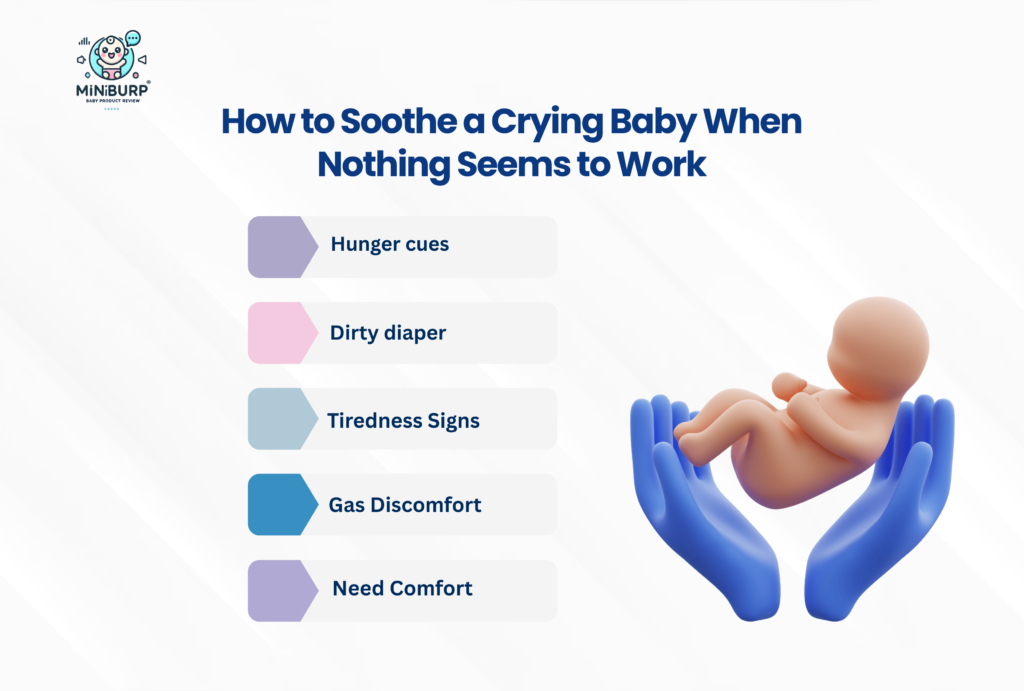Physical Address
304 North Cardinal St.
Dorchester Center, MA 02124
Physical Address
304 North Cardinal St.
Dorchester Center, MA 02124

Crying is the first language of all babies, and though it’s understandable, as parents, we find ourselves at times desperate, confused, and drained for answers. I remember when my newborn interrupted my sleep schedule and I had to wake up at night to soothe her. Thinking to myself, what am I doing wrong? Is the baby hurting? How can I soothe them down?
Years of experience under my belt, supported by pediatrician recommendations and trusted parenting books, have taught me that learning to calm a sobbing infant isn’t all about gimmicks; it’s all about observation, patience, and establishing comfort for parent and baby alike.
At Miniburp, our purpose is to assist new parents with expert-guided advice spiced with personal experience. Through this guide, we will take you through why babies cry, how to soothe a crying baby, indicators that something could be amiss, and when it is time to get some professional guidance.
After going through this guide, you will not only learn how to silence a crying baby but also be sure of your capacity to care for and attend to your little one’s needs.
Babies don’t cry for no reason. It’s the natural method of infant communication between their mothers. They have not learned any words which only crying is the best option to inform their needs.
Although you have done everything like fed the baby, changed the diaper, and even given her colic medicines yet it is still hard for new parents to know how to soothe a crying baby.
As a mother, I exactly understand how these episodes can be, as I recall myself stressed out as I had checked everything, yet still the baby was crying a lot, making me exhausted. It’s the same time when you know being a mother and working simultaneously is not an easy task.
Parents stated that the common time for crying appears in the evening, which typically occurs between 7 pm and midnight. Even at nighttime, babies tend to cry more than during the daytime, making an underdeveloped habit that is not easy to tackle. The common reason for crying is reported to be due to colic pain.
In my own practice, I came to find that my baby’s night crying was not merely about hunger but frequently about requiring a quieter, less stimulating environment. Establishing a consistent evening routine, reducing the lights, decreasing noise, and incorporating calming sounds reduced night crying substantially. You can also use non-WiFi monitors for keeping track of the baby’s sleep routine.

When you’ve checked all the basics and your baby still won’t calm down, it’s time to try different comfort strategies. Here are the most effective, backed by both research and personal parenting experience:
Pediatrician Dr. Harvey Karp introduced the concept of the 5 S’s: Swaddle, Side/Stomach position (while holding), Shush, Swing, and Suck. These mimic the sensations of the womb and trigger a baby’s natural calming reflex.
When my baby was at their fussiest, swaddling combined with white noise worked like magic. The snug wrap created a sense of security, while a steady “shhh” sound or white noise machine reminded them of the safety of the womb just like when you are traveling with an affordable car seat.
One of the most comforting and natural ways to calm a crying baby is skin-to-skin contact. Holding your baby against your bare chest helps regulate their heartbeat, breathing, and temperature.
It also reduces your stress hormones as a parent, making it easier to stay calm. This simple act builds a strong emotional connection while soothing your little one.
Crying can often be linked to hunger or digestive discomfort. Offering a feeding sometimes settles the fuss, but overfeeding can also lead to more discomfort.
After feeding, burping is essential to release trapped gas that might cause pain. I learned this the hard way when I first assumed more feeding was always the answer. Often, a good burp was all it took to calm my baby.
Babies find comfort in rhythmic motion because it mimics the movement they felt inside the womb. Whether it’s rocking in a chair, pushing the stroller, using a baby swing, or even taking a short car ride, motion can be an excellent way to stop crying. Many nights, a simple walk around the living room while holding my baby close worked better than anything else.
Sound plays an important role in calming babies. White noise, lullabies, or even the sound of household appliances like a fan or vacuum can help mask overstimulation and bring calm. When nothing else worked, I often found myself humming softly, and the rhythm of my voice would ease my baby into relaxation.
Sometimes crying is triggered by too much stimulation. Bright lights, loud sounds, or constant activity can overwhelm babies. Reducing stimulation by dimming lights, lowering noise, and moving to a quieter space often helps.
Babies thrive in environments that mimic calmness, so creating a soothing space can make crying episodes shorter and less intense. Also, if you feel sore in breastfeeding, you must try Medela Breast Massage Oil; it’s really good for such cases.
A warm bath is not just about hygiene; it’s a powerful relaxation tool. Warm water relaxes the muscles, and when followed by a gentle massage using baby-safe oils, it provides comfort and bonding time.
Baby massage can also help relieve gas and promote better sleep. This routine became a nightly ritual in my home and drastically reduced evening fussiness.
Sucking is a natural reflex that helps babies self-soothe. If your baby isn’t hungry, offering a pacifier can provide immediate comfort. Some babies prefer breastfeeding for comfort rather than hunger, and understanding this distinction can prevent overfeeding while still soothing effectively.
Using a baby carrier or wrap allows you to keep your baby close while still having your hands free. The closeness, warmth, and rhythmic motion of walking provide a sense of safety that quickly calms many babies. Babywearing not only soothes crying but also strengthens the parent-child bond.
Babies thrive on predictability. Having a consistent routine for feeding, naps, and bedtime reduces fussiness because babies learn what to expect. My baby became noticeably calmer once we set up a structured bedtime routine with dim lights, soft music, and swaddling.
Most crying is normal, but sometimes it can signal an underlying problem. Parents should consult a doctor if:
Trusting your instincts as a parent is key. If something feels off, it’s always better to check with your pediatrician.
Various cultures have distinct ways of soothing babies worldwide, many of which have stood the test of time. In other countries, melodies and lullabies are a nightly routine of soothing a baby, while in other places often include bathing, soft clothing.
Not all practices are scientifically backed, but most parents find solace in the fusion of cultural practices and conventional methods. You can also check our Nanit Pro monitor review for keeping your baby safe and secure.
Perhaps one of the most underaddressed aspects of learning to calm a crying baby is learning to manage your own feelings. A crying baby is hard to handle, which makes a mother exhausted from the energy drain.
Well, it’s okay to take a deep breath and a short break while putting a baby in a crib; relaxing yourself with emotion is more important than soothing a baby. Further, you can also check our guide on comfortable strollers for a enjoyful ride of newly parents.
At Miniburp, we understand parenting can be daunting, particularly when it is about your baby’s comfort and safety. That is why we give you expert-supported guides, product reviews, and genuine advice from parents like me.
Don’t worry if you are tired and feeling dizzy, looking for the right advice, then you can contact Miniburp, and we will guide you with the right amount of tactics.
Calming a crying baby is not just a winning situation, but rather a commitment to your parenthood. It takes patience, love, and new strategies to soothe a baby; with the right strategies and stamina, you can easily create a calm environment for infants that can really boost their health.
As a mother, it’s hard as everything happens so fast, and this life-changing experience can take a toll on your health. But with years of experience, I have learned that everything can be achieved with patience and the right strategies.